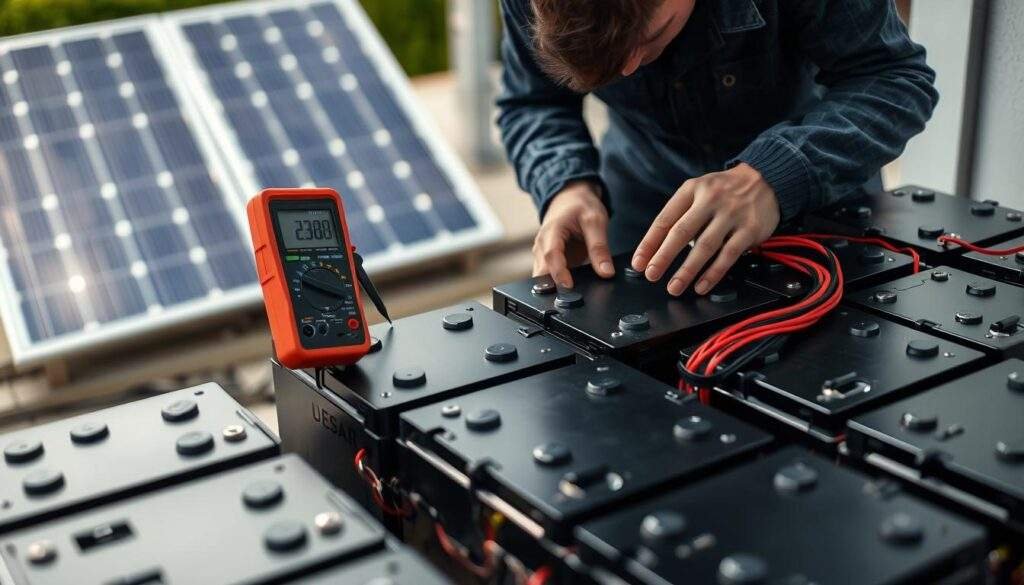Improving Solar Battery Lifespan and Reliability
Thinking about using the sun’s power for your energy needs? You know how key solar energy storage is. A typical American home with solar can cut energy bills by up to $1,000 yearly. But, the solar battery‘s lifespan is a big factor in these savings.
Solar batteries store extra energy from your solar system for later use. But, things like how much you use it, how often you charge it, and the temperature can shorten its life.
Knowing what affects your solar battery’s life can help you make it last longer. This way, you can save more on your energy bills.
Table of contents
- Understanding Your Solar Battery System
- Common Factors That Reduce Solar Battery Lifespan
- Setting Up Your Solar Battery System for Success
- Essential Maintenance Routines for Solar Battery Systems
- Optimizing Charge Controllers to Extend Solar Battery Life
- Temperature Management: Protecting Your Solar Battery Investment
- Monitoring and Troubleshooting Solar Battery Performance
- Specialized Care for Different Solar Battery Types
- Advanced Strategies for Maximum Solar Battery Longevity
- Conclusion
Understanding Your Solar Battery System
To get the most out of your solar panel battery, knowing your solar battery system is key. It stores energy from your solar panels. This way, you can use power even when it’s cloudy or at night. The life and performance of these batteries depend on several things.
Types of Solar Batteries and Their Unique Properties
Solar batteries vary, like lead-acid and lithium-ion, each with special traits. Lithium-ion batteries stand out for their high efficiency and longer life. Knowing your battery type is important for keeping it in good shape.
Key Components That Affect Performance
Your solar battery system’s performance is shaped by a few key parts. These include the battery management system, charge controllers, and the batteries themselves. A good system makes sure your batteries work well, lasting longer.
Measuring Battery Health and Capacity
It’s important to check your solar batteries’ health and capacity often. You can use tools and software to keep an eye on your battery’s state, voltage, and health. This helps spot any issues early, preventing big problems later.
Common Factors That Reduce Solar Battery Lifespan
Knowing what affects your solar battery’s lifespan is key to getting the most out of it. Several things can shorten the life of your off-grid solar battery. It’s important to know about these to keep your battery in good shape.
Temperature Extremes and Their Impact
Extreme temperatures can harm your deep cycle solar battery. High heat speeds up wear and tear, while cold can lower its charge-holding ability. Make sure your solar battery is in a spot with stable temperatures.
Improper Depth of Discharge Patterns
The depth of discharge (DOD) is how much of the battery’s capacity is used. Rechargeable solar batteries used too much can last less long. Watch your energy use and adjust your DOD to keep your battery healthy.
Charging Irregularities and Their Consequences
Charging issues, like overcharging or undercharging, can hurt your solar battery’s life. Overcharging can make it too hot, while undercharging can cause damage. Charging it right is essential for its performance and life.
By knowing and fixing these common problems, you can help your solar battery last longer. This ensures your energy storage system works well.
Setting Up Your Solar Battery System for Success
Setting up your solar battery system needs careful planning and detail. A well-designed system boosts your solar battery backup performance. It also saves energy in the long run.
Consider these key factors for success: optimal placement, proper wiring, and sizing your system right for your energy needs.
Optimal Placement and Environmental Protection
The spot where you place your solar storage system is very important. It should be in a spot that’s safe from extreme weather and other environmental factors.
Proper Wiring and Connection Techniques
Right wiring and connections are key for your energy storage technology to work safely and well. Make sure all connections are tight and wiring follows the maker’s rules and local codes.
Sizing Your System Correctly for Your Needs
Getting the right size for your solar battery system is key. Look at how much energy you use and pick a system that can handle your highest needs. This way, your solar battery backup can help when you need it most.
By paying attention to these important points, you can make sure your solar battery system works great. It will give you a reliable and efficient solar storage system for many years.
Essential Maintenance Routines for Solar Battery Systems
Keeping your solar battery system in top shape is key for reliable renewable energy storage and a good off-grid power solution. Regular upkeep extends your battery’s life and keeps it running smoothly. This means you get a sustainable eco-friendly battery system.
Monthly Inspection Checklist
Monthly checks are vital for your solar battery system. They help ensure all parts are working well.
Visual Inspections
Start with a visual check each month. Look for wear, damage, or corrosion on batteries and connections. Make sure batteries are clean and free from debris.
Connection and Terminal Checks
Check connections and terminals for corrosion or wear. Clean them if needed and tighten loose connections. This prevents power loss and keeps your system safe.
Quarterly Deep Maintenance Procedures
Every quarter, your system needs deeper maintenance. This includes checking charge levels, doing equalization charges if needed, and making sure the battery management system works right.

Annual Professional Assessment
While you can do regular maintenance, a pro should check your system annually. They can spot issues you might miss and do complex tasks that need special skills and tools.
By sticking to these maintenance steps, you can make your solar battery system last longer. It will keep providing reliable and efficient energy storage for your needs.
Optimizing Charge Controllers to Extend Solar Battery Life
Optimizing charge controllers is key to keeping your solar energy system healthy. By adjusting your charge controller, you can make your lithium solar battery last longer. It’s all about knowing how your charge controller works with your solar battery.
Understanding Charge Controller Settings
Charge controller settings are vital for your solar battery’s health. They control how energy from solar panels gets to the battery. Adjusting the charge controller to match your lithium solar battery’s specs is essential for top performance. You need to set the right voltage and current limits to avoid overcharging or undercharging.
Programming for Different Seasons and Conditions
Seasons and weather change how your solar battery works. Programming your charge controller to adjust to these changes is important. For example, in low sunlight, set the charge controller to a lower rate to avoid deep discharging. On sunny days, make sure it can handle more energy.
Advanced Features Worth Utilizing
Modern charge controllers have cool features to boost your system’s performance. Features like maximum power point tracking (MPPT) can make your solar panels work better. Using these advanced features can help store more energy, making your solar battery last longer.
By tweaking your charge controller settings, you can make your solar energy system work its best. This extends the life of your lithium solar battery.
Temperature Management: Protecting Your Solar Battery Investment
Keeping your solar battery at the right temperature is key to its long life. Extreme temperatures can hurt how well your best solar batteries work. So, it’s important to manage temperature well.

Cooling Solutions for Hot Climate Installations
In hot places, it’s important to cool your solar panel battery to avoid damage. You can use fans, shades, or even cooling systems to keep it cool.
Insulation Techniques for Cold Weather Performance
In cold areas, insulation is vital for your solar battery system. It keeps the batteries warm, so they work well even when it’s freezing.
Automated Temperature Control Systems
Automated systems are a smart way to handle temperature changes. They watch the temperature and adjust things to keep your best solar batteries running smoothly.
Using these strategies can make your solar panel battery last longer and work better.
Monitoring and Troubleshooting Solar Battery Performance
Keeping an eye on your solar battery system is key. It helps spot problems early, before they get worse.
Essential Monitoring Tools and Software
You need the right tools and software to monitor your solar battery. They track performance and alert you to any issues.
Battery Monitors and Meters
Battery monitors and meters show your solar battery’s charge, voltage, and current in real-time. Accurate monitoring is vital for knowing your system’s health.
Data Logging Systems
Data logging systems record your solar battery’s performance over time. They help you see trends and spot problems. This detailed insight is key for improving your system’s performance.
Interpreting Performance Metrics
Understanding your monitoring tools’ data is important. Look at metrics like state of charge, depth of discharge, and cycle life. They show how well your system is doing.
- State of Charge (SoC): Shows your battery’s current charge level.
- Depth of Discharge (DoD): Tells you how deeply your battery is discharged.
- Cycle Life: Shows how many charge/discharge cycles your battery has gone through.
Diagnosing Common Issues Before They Escalate
Regular monitoring helps catch problems like sulfation, overheating, or improper charging. Fixing these issues quickly stops them from harming your solar battery.
- Sulfation: Happens when your battery sits for too long with low charge, reducing its capacity.
- Overheating: Can be caused by high temperatures or bad installation.
- Improper Charging: Can shorten your battery’s life and make it less efficient.
By watching for these issues, your off-grid solar battery will work well. It will give you reliable power when you need it.
Specialized Care for Different Solar Battery Types
To get the most out of your solar battery backup system, it’s key to know the special care your battery needs. Each type of solar battery has its own maintenance needs. This ensures they work well and last longer. Tailoring your care to your battery type boosts its performance and life.

Lithium-Ion Solar Battery Maintenance Best Practices
Lithium-ion solar batteries need careful care to avoid overheating and work best. It’s important to keep an eye on their charge level and avoid deep discharges. Also, keep them away from very hot temperatures.
Lead-Acid Deep Cycle Solar Battery Care
Deep cycle solar batteries are made for long, steady power. For lead-acid deep cycle batteries, check the electrolyte levels often and add as needed. Make sure to charge them fully after each use and keep the terminals clean to prevent damage.
Saltwater and Flow Battery Maintenance Considerations
Saltwater and flow batteries have big advantages, like longer life and being more eco-friendly. Keeping the right balance of electrolyte is key. Also, check the mechanical parts, like pumps and sensors, regularly to keep everything running smoothly.
Advanced Strategies for Maximum Solar Battery Longevity
Advanced strategies can greatly improve your solar storage system‘s life. These methods help your renewable energy storage work at its best for many years.
Load Management and Peak Shaving Techniques
Managing your load well is key to your solar battery’s long life. Peak shaving techniques help by reducing battery use when energy demand is high. This prevents damage from too much use.
Using smart load management systems helps distribute energy better. It also lowers the chance of your battery getting too drained.
Implementing Battery Rotation Systems
Battery rotation systems spread the load evenly among batteries. This is great for big solar storage systems, where uneven use can cause early failure. Regular rotation keeps your system running smoothly and extends its life.
Upgrading Components for Better Battery Performance
Upgrading parts can make your renewable energy storage system work better and last longer. For example, new charge controllers can charge batteries more efficiently. This reduces wear and tear.
Also, getting advanced monitoring systems gives you insights into how your system is doing. This lets you make smart choices to keep it running well.
Conclusion
To make your solar battery last longer, it’s important to know what it needs. Follow the best practices for charging, using, and storing it. This way, your solar battery will keep working well for many years.
Proper care and maintenance are essential for your eco-friendly battery system. By using the tips from this article, you can make your energy storage technology work better. You’ll get a steady, green source of power.
By taking good care of your solar battery, you’ll make it last longer. You’ll also help the environment. Your solar battery system will keep giving you clean energy. It will also help you use less from the grid.




